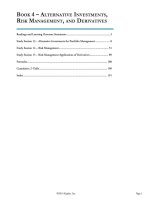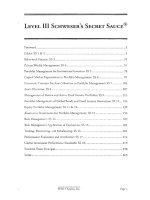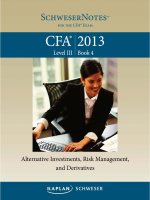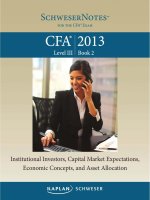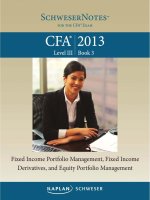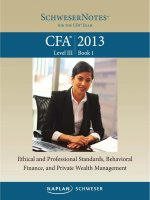2019 CFA level 3 qbank reading 28 active equity investing strategy answers
Bạn đang xem bản rút gọn của tài liệu. Xem và tải ngay bản đầy đủ của tài liệu tại đây (775.41 KB, 19 trang )
10/12/2018
Learning Management System
Question #1 of 27
Consider two equity portfolios with the same benchmark index composed of 943 constituents.
Active equity manager A has constructed a portfolio of 45 high conviction ideas which are
continuously monitored to assess whether their weights in the portfolio remain appropriate.
Active equity manager B has active bets on 550 stocks with automatic rebalancing conducted
on regular monthly intervals. It is most likely that:
A) Both manager A and manager B are following quantitative active equity approaches
following a quantitative active equity approach
.in
B) Manager A is following a fundamental active equity approach and manager B is
fundamental active equity approach
Explanation
en
tre
C) Manager A follows a quantitative active equity approach and manager B follows a
.o
m
bo
ok
c
A fundamental manager will likely have fewer holdings than a quantitative active equity
manager due to the intensive research conducted on individual companies carried out to
generate high conviction investment ideas. This is in contrast to the quantitative manager
who will likely construct a broad portfolio of hundreds of securities in order to generate the
desired exposure to risk factors expected to generate returns based on historical data. The
rebalancing process of a fundamental manager is likely to involve continuous monitoring of
positions for changes in the weights of the portfolio, in contrast to the quantitative manager
who will have a more formal, regular automatic rebalancing strategy based on systematic
rules.
w
w
(Study Session 14, Module 28.1, LOS 28.a)
Related Material
w
SchweserNotes - Book 4
Question #2 of 27
Competitive positioning and environmental, social and governance (ESG) characteristics of a
company are most likely to be used as information sources for:
A) Neither quantitative nor fundamental active equity managers
B) Both quantitative and fundamental active equity managers
C) Fundamental active managers only
/>
1/19
10/12/2018
Learning Management System
Explanation
Competitive positioning and environmental, social and governance (ESG) characteristics of a
company are data that are unlikely to be expressed numerically, and as such are unlikely to
be information used in a quantitative active equity approach. Fundamental active equity
approaches focusing on bottom-up investing could consider such information as part of their
approach.
(Study Session 14, Module 28.1, LOS 28.a)
Related Material
.in
SchweserNotes - Book 4
en
tre
Question #3 of 27
The table below provides information on three stocks being considered for investment by a
bottom-up equity manager
bo
ok
c
123-Year
Sector
Price Month
EPS
Dividend
Company
Industry Sector Average
($) Forward Growth
($)
P/E
EPS
Forecast
5
0.25
20%
T
95
4.75
U
15
5.5
.o
m
S
0.00 Pharmaceuticals
20
3%
0.08 Defence
25
-5%
0.03 Utilities
12
w
w
Which stock is most likely to be the best opportunity for investors that use a relative value
approach?
w
A) Stock S
B) Stock T
C) Stock U
Explanation
/>
2/19
10/12/2018
Learning Management System
Relative value investors look for low price multiples relative to the industry sector. Stock S
has a PE of 5/0.25 = 20x which is equal to the industry average hence stock S is not a relative
value investment. Stock T has a PE of 95/4.75 = 20x which is below the industry average of
25x hence making it potentially a relative value investment. Stock U has a PE of 15/5.5 = 2.7x
which is considerably lower than the industry average of 12. This would suggest the Stock U
would be more appropriate for a deep value or distressed investing strategy than a relative
value strategy.
(Study Session 14, Module 28.1, LOS 28.b)
Related Material
.in
SchweserNotes - Book 4
en
tre
Question #4 of 27
A fundamental active equity investment manager screens the stocks in their universe in order
to create an equally weighted portfolio of securities that have a price-to-book ratio of less than
one. Which of the following pitfalls of fundamental active investing is this manager most likely
bo
ok
c
to be subject to?
A) The value trap
B) Behavioural biases
m
C) The growth trap
.o
Explanation
w
w
By screening the universe and allocating naively for stocks with a low price-to-book ratio the
manager will likely be investing in many securities that appear attractively valued, but are
correctly priced or even overpriced due to seriously deteriorating business conditions. This is
referred to as the value trap.
w
(Study Session 14, Module 28.3, LOS 28.g)
Related Material
SchweserNotes - Book 4
Question #5 of 27
/>
3/19
10/12/2018
Learning Management System
An analyst is backtesting a quantitative investment process which investigates the relationship
between EPS announcements and subsequent month stock returns. The analyst notes that one
speci c company in the universe frequently revises earnings – for example 2017 EPS was
initially announced in March 2018 as $2 when the market expected earnings of $2.10. These
2017 earnings were subsequently revised down to a loss of $1 per share in June 2018 due to
accounting fraud coming to light. In order to avoid look ahead bias, when backtesting the
performance of the stock in April 2018, the manager should use an EPS value of:
A) $2
B) $2.10
.in
C) -$1
en
tre
Explanation
Look ahead bias occurs when using information that was unknown at the time to explain
stock returns. In this case the market did not know in April of the earnings revision that was
to come later in the year, hence stock returns for April should be regressed against the EPS
that was known at the time, that being the $2 initially reported in March.
bo
ok
c
(Study Session 14, Module 28.3, LOS 28.h)
Related Material
m
SchweserNotes - Book 4
.o
Question #6 of 27
w
w
An analyst who wishes to capture the most accurate and up-to-date style exposure of an
investment manager should:
w
A) Prefer to use returns-based analysis
B) Prefer to use holdings-based analysis
C) Be indi erent between using holdings based and returns based analyses
Explanation
An advantage of holdings-based analysis over returns-based analysis is that by looking at
current individual holdings of the fund, an analyst can get the most accurate and current
analysis of the manager's style exposure. In comparison, returns-based analysis uses
historical regression hence will be more of a backward-looking view of the manager's historic
style exposures.
(Study Session 14, Module 28.4, LOS 28.i)
/>
4/19
10/12/2018
Learning Management System
Related Material
SchweserNotes - Book 4
Question #7 of 27
An analyst conducting a returns-based style analysis on an active equity fund constructs the
following monthly multivariate regression:
rt = 0.005 + 0.7LC + 0.3SC + ϵt
.in
Where:
LC = large cap style index
SC = small cap style index
bo
ok
c
εt = residual return not explained by style factors
en
tre
rt = the fund return in period t
The value added by the fund manager is closest to:
A) 0.5% plus the residual return, εt
C) 0.5%
w
w
Explanation
.o
m
B) The residual return, εt
w
In a returns-based regression the slope coe cients are interpreted as the exposure to the
styles during the period, and the intercept term (0.005 or 0.5%) is generally interpreted as the
value added by the manager. The residual term is random and unexplained and hence not
due to manager skill or the style factor exposures.
(Study Session 14, Module 28.4, LOS 28.i)
Related Material
SchweserNotes - Book 4
Question #8 of 27
/>
5/19
10/12/2018
Learning Management System
A quantitative active equity investment manager gathers the following data regarding
information coe cients (ICs) when backtesting the value, growth and size factors in their
investment universe:
Factor
Value
Pearson IC
Spearman Rank IC
insigni cant
signi cantly positive
Growth signi cantly positive signi cantly positive
Size
signi cantly positive insigni cant
If the manager is concerned about biases caused by outliers in the data, they should most likely
.in
conclude that the factors with strong predictive powers for subsequent returns are:
en
tre
A) Value and Growth
B) Growth and Size
C) Value, Growth and Size
bo
ok
c
Explanation
m
The IC measures the correlation between factor scores and subsequent market returns. The
Pearson IC measures the correlation of values which can be biased by the existence of
outliers in the data. In order to avoid this bias, the Spearman Rank IC should be used which
looks at the correlation between the rank of factor scores and the rank of subsequent
returns. The Spearman Rank IC suggests that there is predictive power for the factor when it
is signi cantly positive, i.e. for the value and growth factors.
Related Material
.o
(Study Session 14, Module 28.3, LOS 28.h)
w
w
w
SchweserNotes - Book 4
Question #9 of 27
Which of the following statements regarding activist equity investing is most accurate?
A) Activist investors tend to target companies that have lower than average revenue
growth with negative price momentum
B) Activist investors tend to target companies that have multi-class share structures
C) The assets under management of activist hedge funds decreased sharply during
the global nancial crisis of 2008/2009 and have since failed to recover to pre-crisis
l
l
/>
6/19
10/12/2018
Learning Management System
Explanation
Activist investors will target companies that are not being run e ciently. These tend to be
companies that have slower than average revenue growth and negative price momentum. A
multi-class share structure may hinder activist investors since this usually means that the
founder's shares have multiple votes per share. The comment regarding the assets under
management of activist hedge funds is correct.
(Study Session 14, Module 28.2, LOS 28.e)
Related Material
.in
SchweserNotes - Book 4
en
tre
Question #10 of 27
Company A announces a cash-only purchase of Company B. In order to pro t from this event, a
merger-arbitrage hedge fund manager would most likely:
bo
ok
c
A) Purchase the shares of Company B prior to the deal being announced
B) Purchase the share of Company B and short sell the shares of Company A after the
deal is announced
C) Purchase the shares of Company B after the deal is announced
m
Explanation
w
w
w
.o
In a cash-only merger, the merger-arbitrage manager would purchase the shares of the
target company and earn a risk premium when the deal is closed. This is done after the deal
is announced, since the price of the target company typically remains below the o ered price
until the transaction is completed and the manager can earn a pro t if and when the deal
closes. There is no requirement to short sell the shares of the acquiring company in a cashonly deal – this would be required if the transaction were a stock-for-stock acquisition.
(Study Session 14, Module 28.3, LOS 28.f)
Related Material
SchweserNotes - Book 4
Question #11 of 27
Which of the following statements is most accurate with respect to factor-mimicking portfolios?
A) Factor mimicking portfolios are usually constructed using long only portfolios
/>
7/19
10/12/2018
Learning Management System
B) Factor mimicking portfolios are commonly used in factor-tilting portfolios
C) Factor mimicking portfolios are relatively expensive to construct
Explanation
Factor mimicking portfolios are dollar neutral long/short portfolios that aim to generate a
unit exposure to a single factor. As such they invest in very many positions without regard to
short selling constraints and transaction costs. This can make them very expensive to
construct. Factor tilting portfolios are not constructed using factor mimicking portfolios –
they are portfolios designed to track a benchmark with small tilts towards factors that the
manager expects to outperform.
(Study Session 14, Module 28.2, LOS 28.d)
.in
Related Material
en
tre
SchweserNotes - Book 4
bo
ok
c
Question #12 of 27
Which of the following statements regarding market-microstructure arbitrage strategies is least
accurate?
A) The typical time horizon of a trade is a few minutes
m
B) High-frequency trading techniques are a fundamental part of the strategy
C) The strategy analyses limit order books of exchanges to identify very short-term
w
w
Explanation
.o
mispricing opportunities
w
Market microstructure arbitrage strategies involve extensive analysis of the limit order books
of trading venues to identify very short-term trading opportunities. The time horizon of the
opportunities is usually a few milliseconds.
(Study Session 14, Module 28.3, LOS 28.f)
Related Material
SchweserNotes - Book 4
Question #13 of 27
/>
8/19
10/12/2018
Learning Management System
The table below provides information on three stocks being considered for investment by a
bottom-up equity manager
123-Year
Sector
Price Month
EPS
Dividend
Company
Industry Sector Average
($) Forward Growth
($)
P/E
EPS
Forecast
S
5
0.25
20%
0.00 Pharmaceuticals
20
T
95
4.75
3%
0.08 Defence
25
U
15
5.5
-5%
0.03 Utilities
12
.in
Which stock is most likely to be the best opportunity for investors that use a deep value
en
tre
approach?
A) Stock U
B) Stock S
bo
ok
c
C) Stock T
Explanation
.o
m
Deep value investors look for price multiples that are considerably lower than the industry
sector. Stock S has a PE of 5/0.25 = 20x which is equal to the industry average hence stock S is
not a deep value investment. Stock T has a PE of 95/4.75 = 20x which is below the industry
average of 25x hence making it potentially a relative value investment. Stock U has a PE of
15/5.5 = 2.7x which is considerably lower than the industry average of 12. This would suggest
the Stock U would be more appropriate for a deep value or distressed investing strategy than
a relative value strategy.
w
w
(Study Session 14, Module 28.1, LOS 28.b)
Related Material
w
SchweserNotes - Book 4
Question #14 of 27
With regards to the potential pitfalls in investment strategies, which of the following statements
is likely to be most accurate?
A) A fundamental active equity investor who seeks information that agrees with their
existing beliefs is exhibiting availability bias
/>
9/19
10/12/2018
Learning Management System
B) Over tting is more likely to be a pitfall for a fundamental manager than a
quantitative active equity manager
C) The behavioural bias of overcon dence is more likely to be a pitfall for a
fundamental manager than a quantitative active equity manager
Explanation
.in
Fundamental active equity managers use more subjective judgement than quantitative
managers, and hence are more likely to be subject to behavioural psychological biases that
can distort opinion. Overcon dence, where a manager believes they have abilities beyond
those they actually possess, is an example of a behavioural bias. Over tting is the process of
testing data until a pre-determined model is justi ed which is a pitfall of quantitative
approaches, not fundamental approaches. A manager who seeks information that con rms
their existing beliefs is exhibiting con rmation bias, not availability bias.
en
tre
(Study Session 14, Module 28.3, LOS 28.g)
Related Material
Question #15 of 27
bo
ok
c
SchweserNotes - Book 4
The table below provides information on three stocks being considered for investment by a
m
bottom-up equity manager
T
w
S
w
w
.o
123-Year
Sector
Price Month
EPS
Dividend
Company
Industry Sector Average
($) Forward Growth
($)
P/E
EPS
Forecast
U
5
0.25
20%
0.00 Pharmaceuticals
20
95
4.75
3%
0.08 Defence
25
15
5.5
-5%
0.03 Utilities
12
Which stock is most likely to be the best opportunity for investors that use GARP?
A) Stock T
B) Stock U
C) Stock S
Explanation
/>
10/19
10/12/2018
Learning Management System
Investors that use GARP will consider will invest in securities with low PE-to-growth (PEG)
ratios. Stock S has a PE of 5/0.25 = 20x which is average for the industry, but growth is
expected to be signi cantly higher than the other stocks giving a PEG ratio of 20/20 = 1. The
PE ratio of stock T is 95/4.75 = 20x giving a PEG ratio of 20/3 = 6.6 which is much higher than
for Stock S, making the security less desirable to a GARP investor. Stock U has negative
growth hence would not be appropriate for a growth investor.
(Study Session 14, Module 28.1, LOS 28.b)
Related Material
.in
SchweserNotes - Book 4
Consider the following three companies:
en
tre
Question #16 of 27
Company Listing Return on Assets Asset Turnover Cash Balance
Nasdaq
Low
JBC
Amex
High
LLB
Unlisted Low
Low
bo
ok
c
SBD
High
Average
Average
Low
Low
m
Which of the above companies is most likely to o er an opportunity for activist investing?
A) LLB
w
w
C) SBD
.o
B) JBC
Explanation
w
Activist investors take stakes in publicly listed companies since they often use public proxy
battles and open letters to other investors to push for their value enhancing changes. This
rules out company LLB as a potential activist investment since it is unlisted. An activist will
look for companies that are currently underperforming from a return on assets and assets
turnover perspective and seek to make changes to improve this performance and unlock
value. Company SBD has low return on assets and asset turnover, with high cash balances this suggests the company could bene t from returning cash to shareholders and
repositioning the company to focus on higher productivity xed asset investments. This
makes SBD A good candidate for activist investing. Conversely, company JBC shows no
evidence of ine ciency since return on assets is high and other metrics are at average levels.
(Study Session 14, Module 28.2, LOS 28.e)
Related Material
SchweserNotes - Book 4
/>
11/19
10/12/2018
Learning Management System
Question #17 of 27
Consider the following two statements regarding the hedged portfolio approach to
implementing factor-based active equity investing strategies:
Statement 1: Restrictions on short selling securities will likely prevent the strategy being
implemented
Statement 2: When constructed properly, hedged portfolios represent pure exposure to the
.in
factors they are designed to represent
A) Both statements are false
B) Both statements are true
C) Statement 1 is true and statement 2 is false
bo
ok
c
Explanation
en
tre
It is most likely that:
m
The hedged portfolio approach constructs portfolio that represent factors through ranking
securities by the factor and buying top quantile securities whilst shorting bottom quantile
securities. Statement 1 is therefore true. Statement 2 is false: a major drawback of the
hedged portfolio approach is that the portfolios created are not pure factor portfolios since
they will have signi cant exposure to other risk factors outside the factor being modelled.
Related Material
.o
(Study Session 14, Module 28.2, LOS 28.d)
w
w
w
SchweserNotes - Book 4
Question #18 of 27
Data for US companies show that in the years after activist investing, companies on average
have:
A) Higher return on equity and leverage levels
B) Lower return on equity and lower leverage levels
C) Higher return on equity and lower leverage levels
Explanation
/>
12/19
10/12/2018
Learning Management System
Data for US companies subject to activist investing show that on average fundamentals of a
company such as revenue growth, EPS growth, return on equity and corporate governance
indicators improve in the years after activist investing. Price momentum also signi cantly
improves. The data also show that on average these improvements come at the cost of
higher debt/equity ratios.
(Study Session 14, Module 28.2, LOS 28.e)
Related Material
SchweserNotes - Book 4
.in
Question #19 of 27
en
tre
A factor-based quantitative active equity investment manager is investigating the relationship
between treasury yields and factor returns. They regress both contemporaneous and
subsequent month factor returns against the 10-year treasury bond yield. The factors used are
systematic risk (beta), size (market capitalisation) and value (book-to-market). The regression
w
w
w
.o
m
bo
ok
c
coe cients are displayed in the chart below:
Based on the regression coe cients above, which of the following strategies is most likely to be
pro table:
A) Short high beta securities and long value securities in months subsequent to
treasury yields being high
B) Long high beta securities and short value securities in months where treasury
yields are high
/>
13/19
10/12/2018
Learning Management System
C) Long high beta securities and short value securities in months subsequent to
treasury yields being high
Explanation
The regression coe cients indicate there is a positive relationship between bond yields and
returns to high beta securities in the subsequent month. Hence high beta securities should
be bought the month after high treasury yields have been observed. There is a negative
relationship between bond yields and returns to value securities in the subsequent month,
hence value securities should be sold in the month after high treasury yields have been
observed.
(Study Session 14, Module 28.2, LOS 28.d)
Related Material
en
tre
.in
SchweserNotes - Book 4
Question #20 of 27
bo
ok
c
A top down portfolio manager using a short straddle position to express their view on market
volatility will most likely earn excess returns when:
A) Implied volatility is lower than realized market volatility
m
B) Market volatility levels fall
Explanation
.o
C) Realised market volatility is lower than implied volatility
w
w
w
A manager using a short straddle position is selling calls and puts with the same strike price
and expiry in the expectation that realised market volatility will be lower that implied
volatility currently factored into option prices. Market volatility levels falling on its own does
not guarantee that the manager will earn excess returns since this fall in volatility may
already be priced into the implied volatility of options.
(Study Session 14, Module 28.1, LOS 28.c)
Related Material
SchweserNotes - Book 4
Question #21 of 27
/>
14/19
10/12/2018
Learning Management System
A portfolio overlay derivatives strategy can be employed by a portfolio manager for all the
following purposes, except:
A) Removal of unintended macro exposures created by a bottom-up fundamental
investment process
B) Adding active returns that are not correlated with the underlying portfolio strategy
C) Identifying overvalued/undervalued securities for stock selection
Explanation
(Study Session 14, Module 28.1, LOS 28.c)
Related Material
Question #22 of 27
bo
ok
c
SchweserNotes - Book 4
en
tre
.in
A portfolio overlay strategy uses derivatives positions to remove unintended macro
exposures generated by the portfolio management process. It can also be used to attempt to
generate excess return from areas that are uncorrelated with the underlying portfolio
strategy. Being a top-down strategy, a portfolio overlay will focus on macro sectors rather
than individual stock selection.
m
The Information coe cient is best de ned as:
.o
A) The correlation of the performance of a hedged portfolio representing returns to a
w
w
factor and a fundamental driver of factor performance such as interest rates across
i
B) The cross-sectional correlation of factor scores verses subsequent stock returns
w
across an investment universe
C) The correlation of the performance of a hedged portfolio representing returns to a
factor and the returns of the manager’s portfolio
Explanation
The information coe cient is calculated as the correlation between the factor score of a
security and the subsequent return of the security. If the information coe cient is high this
implies the factor has predictive power.
(Study Session 14, Module 28.3, LOS 28.h)
Related Material
SchweserNotes - Book 4
/>
15/19
10/12/2018
Learning Management System
Question #23 of 27
According to Morningstar's classi cation criteria for Value/Growth stocks, a security with a net
style score of close to zero is classi ed as
A) Growth
B) Value
C) Core
.in
Explanation
Related Material
SchweserNotes - Book 4
.o
m
Question #24 of 27
bo
ok
c
(Study Session 14, Module 28.4, LOS 28.i)
en
tre
The Morningstar Value and Growth Scoring scheme allocates a score out of 100 to a stock for
growth attributes and for value attributes. The net style score is the growth score minus the
value score. If the net style score is strongly negative the stock is classi ed as value. If the net
style score is close to zero then the stock is classi ed as core. If the stock has a net style
score that is strongly positive then it is classi ed as a growth stock.
When comparing fundamental and quantitative approaches to active equity investing, which of
w
w
the following statements is most accurate?
A) Manager judgement plays a large role in fundamental active equity approaches, but
w
plays no role in quantitative active equity approaches
B) Company nancial statements would likely be a source of information for
fundamental approaches but not for quantitative active equity approaches
C) Factor based modelling is likely to play a greater role in quantitative approaches
than fundamental approaches to active management
Explanation
/>
16/19
10/12/2018
Learning Management System
Factor based modelling is a key ingredient of quantitative active equity approaches, since
their focus is on identifying relationships between rewarded factors and stock returns.
Company nancial statements are likely to be a source of information for both fundamental
and quantitative approaches, since accounts can be used to generate a fundamental opinion
or to establish exposure to a quantitative factor such as valuation. Manager judgement plays
a role in both fundamental and quantitative approaches – the fundamental manager will use
judgement in making investment decisions, whilst the quantitative manager will use
judgement in building models, particularly in deciding which factors and signals are relevant.
(Study Session 14, Module 28.1, LOS 28.a)
Related Material
Question #25 of 27
en
tre
.in
SchweserNotes - Book 4
An analyst is investigating potential pairs trades for a statistical arbitrage fund. She gathers the
bo
ok
c
following information about three potential pairs:
Pair 1 consists of two car manufacturers. One of the companies is a small new
manufacturer of electric self-drive vehicles, the other companies is one of the
largest car manufacturers in the world established over 100 years ago. The mature
company has recently made signi cant investment in new electric vehicles. The
m
historical correlation of the two companies has been low.
.o
Pair 2 consists of two mature advertising agencies that have comparable future
w
w
earnings prospects. Both typically trade on similar valuations and the historical
correlation of share prices has been high. The ratio of share prices is currently 1.5
w
standard deviations below its moving average
Pair 3 consists of two mature companies: one is a cement manufacturer and the other is a
thermal coal company. Although the companies operate in di erent markets and have di erent
business models the stock prices have historically shown high correlation. A recent news
announcement has caused the ratio of share prices to deviate from the long-term average.
The pairs trade the analyst should most likely recommend is:
A) Pair 3
B) Pair 1
C) Pair 2
Explanation
/>
17/19
10/12/2018
Learning Management System
Pair 2 is the most suitable for pairs trading strategy since the companies are similar
businesses and share prices have shown strong correlation in the past. Pair 1 is
inappropriate because the business model of the companies and market valuations are likely
to be very di erent. Pair 3 is inappropriate since the companies operate in di erent sectors
and hence any correlation between share price is likely to be spurious and not persistent into
the future.
(Study Session 14, Module 28.3, LOS 28.f)
Related Material
.in
SchweserNotes - Book 4
en
tre
Question #26 of 27
Which of the following investment strategies is least likely to be a top-down investment
strategy?
A) Volatility based strategies
bo
ok
c
B) Special situations strategies
C) Thematic investment strategies
Explanation
w
w
.o
m
The special situations investment style focusses on mispricings occurring due to corporate
events such as mergers, acquisitions, spin-o s and divestures. These corporate events relate
to individual company information and hence this is a bottom-up strategy. Both volatility
based and thematic investment strategies look at markets as a whole and hence are more
likely to be top down strategies.
(Study Session 14, Module 28.1, LOS 28.c)
Related Material
w
SchweserNotes - Book 4
Question #27 of 27
When creating a fundamental active investment strategy an active equity manager should
assign a price target that they believe to be the fair value of the security. Which of the following
statements regarding this price target is most accurate?
/>
18/19
10/12/2018
Learning Management System
A) The price target should not be adjusted after it is set at the outset in order to avoid
su ering from behavioural biases such as loss aversion
B) Adjusting the price target down in response to negative news ow until it is lower
then the current market price would trigger a sale or reduction in the position size.
C) The stock position should always be fully liquidated as soon as the security reaches
the price target.
Explanation
Related Material
w
w
w
.o
m
bo
ok
c
SchweserNotes - Book 4
en
tre
(Study Session 14, Module 28.3, LOS 28.g)
.in
The price target speci ed in a fundamental investing strategy need not be xed but can be
updated to re ect changing market conditions since the position was established. The
manager should recognise that the fair value of the security is an estimate and therefore
would not necessarily liquidate the full position as soon as the stock reaches the price target,
instead choosing to reduce the position.
/>
19/19
